In a showdown of acrylic vs oil paint, which one is better?
Below, you’ll find out the difference between oil and acrylic paint and what each has to offer.
You’ll learn the high points and potential drawbacks of the two paints.
And finally, we’ll compare side-by-side aspects like cost, drying times, color quality, and safety (with some bonus painting tips!) to help you figure out which medium is best for you…
Contents
What Are Oil Paints?
Oil paints are thick, buttery, slow-drying paints made by combining an oil (usually linseed oil) and a pigment (color).
Oil painting, as we know it today, has a long history, from being used regularly by master painters from around the 15th century to contemporary painters working in their studios.
Its blend-ability makes it perfect for anything from portrait painting to landscape to abstraction.
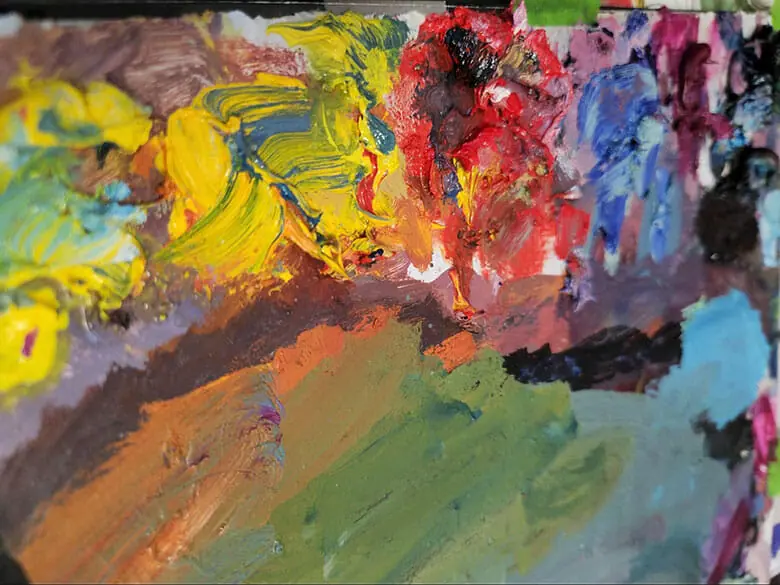
Oil Painting Pros
- Oil paints have slower drying times compared to other paints, making them extremely workable and blendable on the canvas.
- You don’t have to worry about your paints drying out on your palette. You can take your time making the perfect color mixtures and don’t have to rush any decision-making.
- A small amount of oil paints go a long way, especially when painting mediums are added to them.
- The colors you mix on your palette will stay the same value once they are dry. There are no surprises in how a painting will turn out once dry, and it is easy to color match when necessary.
- Oil paintings are long-lasting and durable with the right care, as evidenced by the countless paintings in museums and collections that are hundreds upon hundreds of years old.
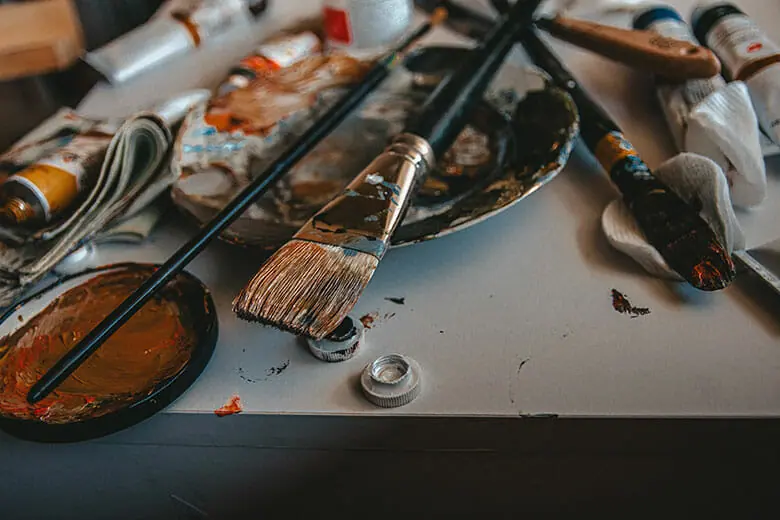
Possible Oil Painting Cons
- The slow drying time might be considered a con if you need a painting to be finished quickly for a deadline.
- Some pigments “sink” into the canvas upon drying, so certain areas of a painting can look more dull and matte. (This uneven finish can be solved later with varnish, though.)
- Oil painting involves some toxic materials, like solvents, so it requires extra safety precautions.
What Are Acrylic Paints?
Acrylic paint is water-based synthetic paint that is made mainly of plastic-y acrylic resin and pigment. Some might say that acrylic blends some of the best properties of oil and watercolor paint.
Acrylic paints are much younger than oils. It might seem like they’ve been around forever, but they’re a product of the mid-20th century.

Acrylic Painting Pros
- Acrylic paints dry quickly, so it’s possible to have a finished painting in a short amount of time. You can also add new layers right away and create sharp edges easily.
- They are far less toxic to work with than oil paints. You can use them anywhere without worrying about harmful fumes or the disposal of flammable waste.
- Since you only need water to dilute them and to clean up, you don’t have to buy and learn to use any extra supplies and materials.
- Acrylic paint is more affordable starting out, so it’s great for artists on a budget.

Possible Acrylic Painting Cons
- The quick-drying might not be for you if you like to take your time and work wet-on-wet, doing a lot of blending.
- Acrylic colors often dry a little darker, so it can be a challenge to color match while painting. You have to account for this difference as you mix your colors. This can be tough for a beginner painter to get used to.
Oil vs Acrylic Costs: Which Is More Expensive?
Up front, there may seem to be a clearly cheaper option between oil and acrylic, but there are some additional factors to consider that bridge the overall costs between the two a bit.

Cost of Acrylic Paints
Acrylic paint is more affordable than oil paint tubes of the same or similar size.
Painting with acrylics also requires fewer supplies overall since no oil medium, solvents, or special clean-up materials are necessary.
However, acrylic paints dry out quickly, so waste is often involved.
They also do not stretch as far on the canvas, so you may find yourself replacing your paint more often than you would with oils.
Student-grade acrylic paints, like Liquitex’s Basics line, are inexpensive but are typically thinner, less pigmented, and include fillers.
Professional Artist-grade acrylic paints, like Golden’s Heavy Body Artist Acrylic Paints, are more expensive but are gorgeous, thick paints that retain brushstrokes and have a finished look closer to that of oils, including the same lightfast qualities.

Cost of Oil Paints
Oil paints have a reputation for being expensive, but because they stay wet on the palette longer, you can get away with buying less colors initially because it’s easy to mix them on your own.
You won’t be scraping away and throwing out nearly as much paint from your palette.
Each paint tube also tends to last a long time because using a medium extends them on the canvas.
Additionally, oil painting materials like solvent can be recycled and reused, so one bottle of gamsol can last you ages!
If you’re on a budget and want to start painting right away, however, the startup costs with all of the different oil painting supplies can be a little intimidating.
Student-grade oils like Winsor & Newton’s Winton are more affordable but less pigmented.
Artist-grade brands vary greatly in price, from Winsor & Newton’s Artist Oil Colors to Old Holland’s hand-made, highly pigmented oil paints.

Oil Paint vs Acrylic Paint Safety
Safety concerns involving any paint medium are valid and important to consider!
Especially if you’re hoping to make painting a regular part of your life and even more so if you’re working from home and sharing your space with others.
Below, let’s look at the relative safety and the difference between acrylic and oil paint.

Safety of Acrylic Paints
You don’t have to stress much about safety when using acrylic paints.
They don’t put off dangerous fumes as some oil painting materials do, so they’re better suited for painters who don’t have access to a well-ventilated area for painting.
For the same reason, you can rest easier using them if you have children and pets around, too.
However, they should still not be ingested. Whether you’re using oil paint or acrylic, some pigments, like cadmium, may be toxic, so avoid those colors if you are concerned.
Safety of Oil Paints
Oil painting brings up more safety concerns, but you can address them by taking the proper precautions and building safety guidelines into your way of working.
Solvents
Solvents are the biggest health risk to an oil painter. They produce dangerous fumes that can cause a number of serious adverse health symptoms. If ingested, they can even be fatal.
So naturally, it is VERY important to only use them in well-ventilated areas, to label all jars, and keep them safely away from children and pets.
Hardware store odorless mineral spirits may be cheaper, but artist-grade solvent like Gamblin’s Gamsol is formulated to be less toxic.

Waste Disposal
Additionally, oil-soaked paper towels and rags may spontaneously combust under the right conditions, posing a fire risk if not disposed of properly.
It’s best not to crumple them up, so let them dry out flat or in a sealed metal trash can to prevent possible fires.
Toxic Pigments
Toxic pigments like cadmium and leads can be used safely with gloves or avoided entirely by choosing comparable “cadmium free” or “cadmium hue” pigments.

Gamblin has formulated cadmium pigments that are less toxic and safe to use!
Drying Times
We know now that the drying times of oil and acrylic paint are at opposite ends of the scale.
And that slow-drying AND fast-drying can be either beneficial or frustrating in different situations to different painters.
Which is preferable depends entirely on your needs and expectations.
But, there are also ways to alter the drying times (somewhat!) of both types of paint to suit your needs.
Acrylic Paint Drying Time
You can put down thin layers of acrylic paint, and they’ll dry in a few minutes.
This makes it great for more graphic work with distinct edges and fine lines but a little more challenging when it comes to subjects like painting portraits. (Although, this is still absolutely doable!)
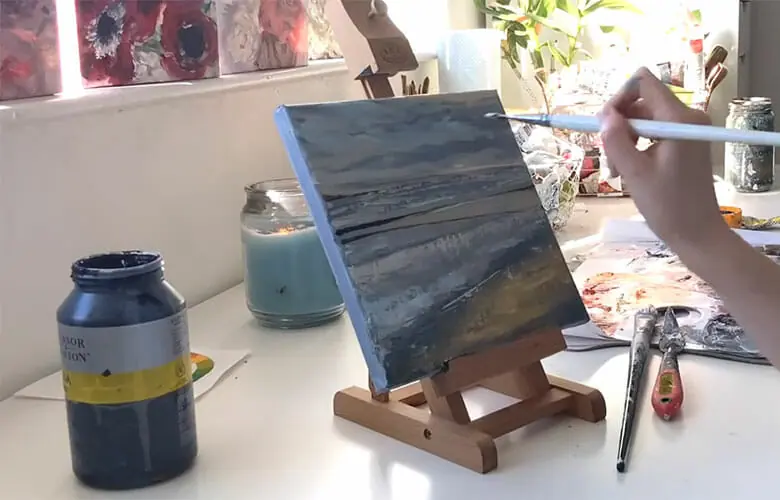
- If you want more working time on the canvas, you can mix a slow-drying acrylic medium into your paints. It can double the drying time and give you a painting experience closer to that of oils.
- Since acrylic paint dries quickly on the canvas, it also dries quickly on the palette. If you want more time for mixing acrylics, try Masterson’s Sta-Wet Palette. A stay-wet palette is the best solution to keep your acrylic paint wet for days and to mix colors to last.
Oil Paint Drying Time
What does “slow-drying” really mean?
So many factors influence how quickly oil paints dry, but ultimately oil paints go through a two-step drying process.
Depending on the thickness of application and the oil paint medium used, oil-based paints can be touch-dry within a couple of days to a week, usually.
Then, the second drying stage occurs, a longer curing process where the paint hardens over a period of up to 6 months.

- If you would like your oil paints to dry even more slowly, using oils like walnut and safflower oil as your medium will slow the process down even further for maximum working time.
- If you want your oil paints to dry more quickly, then resin-based quick-drying mediums like galkyd or liquin can cut drying times by up to 50 percent.
Learn more in-depth info about how to influence drying times in our guide on how long does it take for oil paint to dry.
Mess Level
All paint has the potential to cause a mess, but how messy are we talking?
Imagine cleaning up spilled water. Now imagine cleaning up spilled oil.
One is typically a quicker clean-up than the other. But there are measures to take to keep acrylic and oil messes to a minimum and methods to use that make clean-up easier for both types of paint.
A simple apron, drop cloth, and nitrile gloves make a great team for protecting your clothes, floor, hands, and emotional state.

Acrylic Paint Messes and What to Do About Them
Since acrylics dry quickly, a spill will only cause a mess where the paint initially ends up, keeping the mess pretty contained.
While wet, it’s usually easy to clean from fabric with soap and water. But once it dries, it can be difficult to get out of clothes or carpet since it dries like a plastic film.
If it does dry, you can try rubbing some alcohol on the stains and then cleaning with regular soap.
Oil Paint Messes and What to Do About Them
The qualities that make oil paints so great for working a long time on the canvas also make it slow-drying and easy to spread anywhere and everywhere else if you’re not careful.
A small dab of misplaced phthalo green paint (infamous for staining, cue the horror film music) can end up all over your house.
But, there are ways to clean up the mess if you’re quick enough.
Keep some baby oil on hand to remove wet oil paint from your clothes or fabric furniture, then wash them as usual with laundry or dish soap.
A tube of Kiss-Off Stain Remover is also a lifesaver and can even remove dried oil paint in some circumstances.
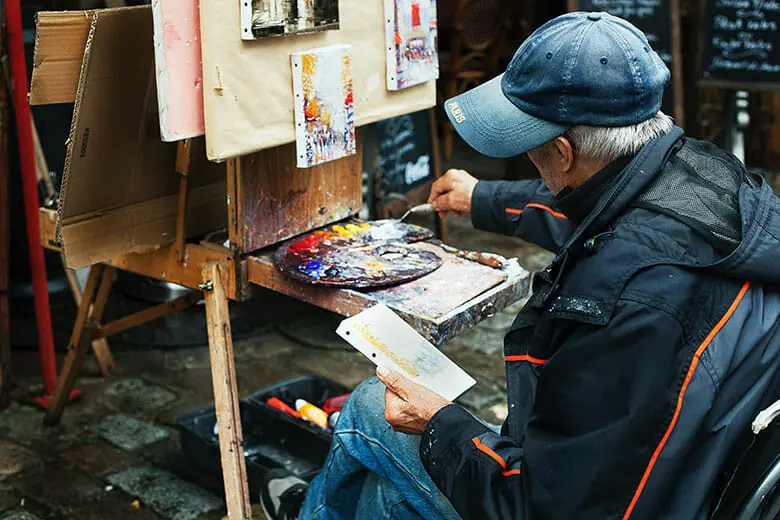
Differences in Cleaning Brushes
Brush cleaning is an important part of the painting process, with either acrylics or oils.
Keeping your brushes in good shape will allow you the best control of your materials as you paint and save you money in the long run.
Acrylic and oil painting require different cleaning and care methods for your brushes since acrylic is water-based and oils have an oil base.
Cleaning Acrylic Paint Brushes
Cleaning acrylic paint brushes is quick and easy as long as you do so while the paint is still wet.
All you need is water, soap for stubborn colors, and then pat them dry with a paper towel. Set your brushes aside to dry flat to retain their shape and you’re all set.
However, if you forget to clean your acrylic brushes before they dry, you’ll end up with a stiff, unworkable brush that is usually not worth trying to save.
Some people think leaving dirty brushes in a water container is a solution, but this will cause the bristles to lose shape and deteriorate faster.
The best practice is just to be mindful and clean your brushes frequently as you go.

Cleaning Oil Paint Brushes
Cleaning oil paint brushes is a multi-step process since oils are so stubborn.
The easiest way to clean brushes as you go is to use solvent while still painting.
When you’re done painting for the day and need to thoroughly clean your brushes, first remove any excess paint with a rag. Then use baby oil to dissolve whatever paint is left, before taking them to the sink and cleaning the oil off with an oil-based soap like Fels Naptha.
The upside to cleaning oil paint brushes is that since oil is slow-drying, you’ll be okay if you get busy or forget and need to clean them the next day. They’ll still be fine (unlike the disaster that would be waiting if you forgot about any acrylic paint-covered brushes)!

Color Quality and Durability
The drive to match what we observe and translate what we imagine through the perfect color mixtures can be enough to inspire painters for a lifetime.
Finding the best paints to work with means looking for a high concentration of quality pigments, consistency of mixtures, and the least amount of fillers possible in whichever paint medium you choose.
Color Quality and Durability of Acrylics
Artist-grade acrylics, like Golden’s, are made with the highest pigment concentration possible for each specific color. They are permanent and lightfast, so the colors will not fade over time.
With acrylic paints in general, there is a tendency for some colors to dry a bit darker, but once dry, they retain their color and there’s less chance of future yellowing than there is with oil paints.
Acrylic paintings are also durable and not prone to cracking over time either.

Color Quality and Durability of Oils
On the other hand, oil paints will dry the same colors you put down when they’re wet, but could potentially be yellow over time.
Using refined linseed oils, walnut oil, or safflower oil as your medium instead of typical linseed oil will help with this problem because they are less prone to yellowing.
Professional artist-grade paints like Old Holland or Gamblin Artists’ Oils are as vivid as possible and formulated to be lightfast and permanent.
While oil paintings are durable and last hundreds of years, they can also be prone to cracking.
Using slower-drying mediums like walnut oil and safflower will also prevent future cracking. Another solution is to follow the rule of working “fat over lean”. This means you should paint thinner layers with less oil initially, and thicker, more oily layers over top of them.

Stand Out Features of Oils and Acrylics
Working Wet-on-Wet with Oil Paint
Oil paint is the perfect medium for the wet-on-wet technique known as the alla prima.
You can work loosely and expressively, allowing the paint to blend and mix on the surface as you go.
Since oils won’t dry out on you, you can also take a moment to consider your work and make adjustments to your liking carefully.
It allows you to put in edges and blend them softly, to lay down paint and scrape it away when necessary.
Plenty of unexpected and welcome surprises can come from working wet-on-wet with oils, and you can make paintings that you might not have imagined in another medium.

Finishing Paintings More Quickly With Acrylic Paint
If you find yourself with deadlines for whatever reason, whether for commissions, holiday gifts, or an upcoming show, painting with acrylics will ensure that your paintings will be dry on time.
You also don’t have to worry about waiting months to properly varnish a piece like you have to with oils.
Best Acrylic Paint Sets
Golden’s Heavy Body Artist Acrylic Paint set of 8 is made specifically for color theory and mixing. It has the perfect range of colors to start with.
Liquitex’s Professional Heavy Body Acrylic Paint set of 12 includes an even broader selection of warm and cool colors in thick, high-quality acrylics, giving you plenty to work with and mix what you need.

Best Oil Paint Sets
This set of 9 Gamblin’s Artist Oil Colors comes with a selection of colors perfect for mixing anything necessary. Gamblin’s cadmium colors are also specially formulated to be safer, so much so that they do not require the same warning labels as cadmium pigments in most other oil paint brands.
While at a higher price point, this introductory set of 10 tubes of Old Holland’s Classic Oil Colors is some of the highest quality paint you can find. It is hand-made with the same pigments and processes that the old masters themselves painted with.
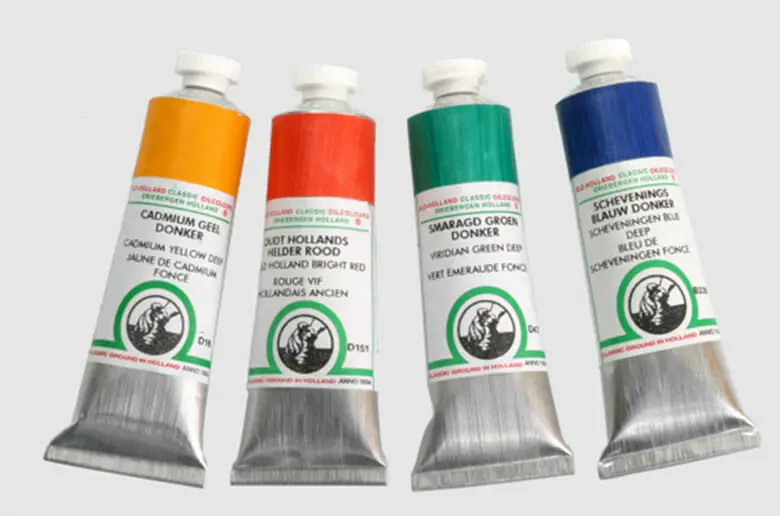
Is Acrylic or Oil More Beginner Friendly?
Both acrylic and oil paints are beginner friendly. Oil paint has a learning curve starting out, but most foundation classes teach beginners with oil paint.
Acrylic painting might be easier to pick up on your own since it requires less material. Still, classes can help beginners overcome the obstacles that might initially make oil painting seem intimidating.
If you’re unsure where to start, Evolve Artist offers a great free Oil Painting for Beginners mini-course that will give you some helpful exercises and instructions for where to begin!
Where Can I Go to Learn Acrylic Painting?
To learn acrylic painting, look to New Masters Academy, which offers thousands of hours of art lessons and courses through their subscription-based learning platform.

This includes their Introduction to Acrylic Paint lesson, along with lessons on specific subjects for acrylic paintings like Painting a Head with Acrylics or Painting a Seascape with Acrylics!
Whatever you find yourself stuck with, there’s help there for you, in any medium. Find out more in our full New Masters Academy review.
Where Can I Go to Learn Oil Painting?
If you want to learn everything there is to know about oil painting with incredible depth and guidance, Evolve Artist’s online oil painting course is my personal favorite.

They provide high-quality materials for you (including Old Holland paints), break down lessons into easy-to-understand blocks of study, and give you valuable 1-on-1 feedback as you learn to make stunning oil paintings at your own pace.
Learn even more about Evolve in our full Evolve Artist Review and save $100 with our coupon code ARTIGNITION100 when you click below to sign up for Evolve Artist
Frequently Asked Questions

Is It Better to Paint With Oil or Acrylic?
It depends on your needs and preferences. Both are great options, but if you want quick-drying, less toxic paint, go with acrylics. If you want to work more slowly and use wet-on-wet techniques, go with oil.
Do Famous Painters Use Oil or Acrylic?
Most famous painters historically have used oil, because oil has a longer history. So almost all recognizable famous paintings, like the Mona Lisa and Starry Night, are oil paintings.
Is Oil Painting Easier Than Acrylic?
Oil painting involves more steps and materials than acrylic, but your paints won’t dry out on you, so it is easier in that sense.
Does Acrylic Paint Last as Long as Oils?
On the palette, no. As a finished painting, yes. Acrylic paintings are very durable and not prone to cracking or yellowing.
Is Acrylic Paint Oil Based?
Nope! Acrylic paint is not oil based. It’s a water-based paint.

Acrylic vs Oil Paint?
Oil and acrylic paint each have their unique challenges and benefits to offer.
Only you can decide what you need most as a painter. Now that you know the qualities of both oil and acrylic paints, you can be sure to work with the right materials for your needs.
- If you want to work quickly and inexpensively, you may want to choose acrylic painting…
If you choose acrylics, then I recommend starting with this set of Golden’s Heavy Body Acrylic Paint and trying out New Master Academy’s Intro to Acrylic Painting course. - If you enjoy working slowly, mixing colors, and having the maximum ability to use blending techniques, then oil paints work beautifully for those purposes.
If you choose oils, then I recommend learning with Evolve Artist, who will provide all the paints and equipment you need.
Whichever you pick, happy painting!



